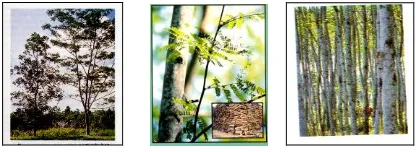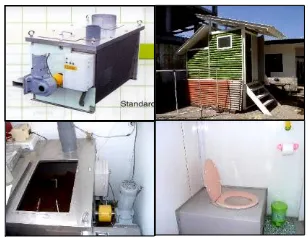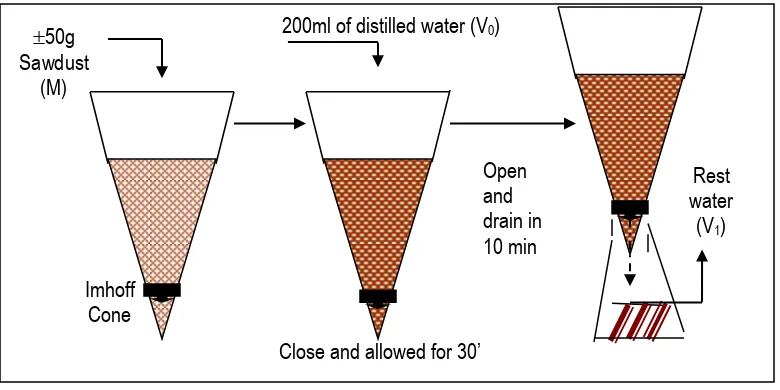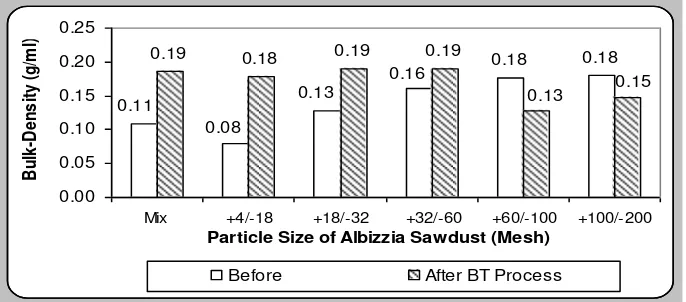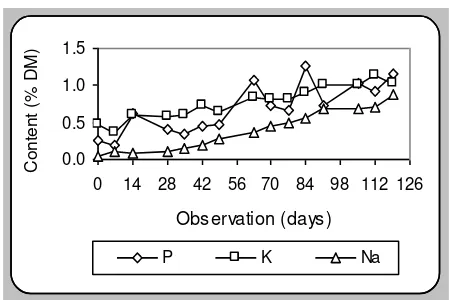Physical and Chemical Characteristic of Albizzia Sawdust as a Matrix in the
Decomposition of Human Excreta Using Bio-toilet
Jovita Triastuti, Neni Sintawardani, and Mitsuteru Irie
Abstract
Bio-toilet (BT) is a dry closet that using sawdust as an artificial soil matrix due to the benefit characteristics of sawdust it self. In this study, Albizzia (Paraserianthes Falcataria) sawdust from a local sawmill was used as matrix in the decomposition of human waste in BT system. The study was carried out at Pesantren Daarut Tauhiid Bandung for about 4 months using BT type S-50 from Seiwa Denko Ltd, Japan. The human body waste from 25 students was loaded daily. Mixer was setting to run-on automatically with 15 minutes interval for 2 minutes; 1 minute to clockwise and counter-clockwise rotation respectively. Exhaust fan was operated continuously for aeration. Heater was run-off at first 2 months, and run-on at last 2 months. The physical and chemical properties of Albizzia sawdust, before (fresh) and after process (residual) were observed. Data showed that friction both among sawdust particles and between sawdust and screw material caused the particle size reduction due to the mechanical effect of mixing. Bulk density of sawdust increased (0.187 > 0.109 g/ml). Water retention increased from 2.09 to 2.55 ml/g. C/N ratio decreased significantly, from 200:1 to 27:1. Ash content of residual is higher than fresh sawdust (7.11 > 3.32%). The extractive compounds increased (3.68 > 1.8%). Lignin content tends increase, from 27.71 to 29.74% DM, meanwhile cellulose content decrease. Mineral P, K, and Na increased significantly during process. It was concluded Albizzia sawdust can be used as matrix in BT, but the residual should be replaced with fresh after 4 months usage due to maintain of BT performance. Residual sawdust has agood point as soil fertilizer due to its water retention, air capacity, and the high NPK content that would be valuable for plant.
Key words: Albizzia sawdust, bio-toilet, decomposition, feces-urine, physical-chemical properties.
Introduction
The Onsite Wastewater Differentiable Treatment System (OWDTS) is an ecological sanitation approach with high potential to achieve sustainable treatment and management of domestic wastewater (Zavala et al. 2002). Based on OWDTS, bio-toilet (BT) that using sawdust as artificial soil matrix has been developed (Terazawa 2006). Sawdust itself has some benefit characteristics as matrix, i.e. high in porosity, high in void volume ratio, high of water and air retention, and bacterial tolerant. Low apparent density of sawdust is a good point for mixing process due to its low consumption of energy. The principle of BT is aerobic decomposition of toilet wastes (feces and urine) by bacteria resulted carbon dioxide (CO2) and water (H2O) that will be evaporated-out of the system. Trace minerals and nitrogen remained and accumulated in the matrix. After several months ( 6 months) residual sawdust which rich in N, P, and K can be harvested and used as soil conditioner (Kitsui and Terazawa 1999).
The previous investigator (Horisawa et al. 1999) used varying wood sawdust as matrix for BT experiment, such as Todomatsu (Abies sachaliensis) and Karamatsu (Larix kaemferi). Another researcher used sawdust mixture from a furniture industry waste (Liu et al. 2005), and corn stalk (Sheng et al. 2005). In fact, the performance of BT is depending on the kind of sawdust,
place. Therefore, it is important to utilize the indigenous raw material due to implementation purpose of this technology in the future.
Figure 1. Albizzia tree and wood.
In Indonesia, Sengon (Paraserianthes falcataria) from family Leguminoceae and subfamily Mimosoidae is widely distributed. It is very fast growing tree. Under favourable conditions reaches 15 m in height within 3 years. The fiber length of this wood material is 1.0~1.1 mm, width 24~42 m, and the cell wall is thin (Ilvessalo 1995). There are some local names of Albizzia in Indonesia (Atmosuseno 1997), such as Sengon Laut
sawdust was used as matrix in the decomposition of human waste in BT system. The physical and chemical properties of Albizzia sawdust, at before and after using in BT were discussed in this paper.
Materials and Method
Date and Place
The study was carried out from 26 October 2004 to 20 February 2005 ( 4 months) at Pesantren Daarut Tauhiid, a famous Moslem Religion School in Bandung, Indonesia.
Material, Equipment, and Operation Condition
63 kg of Albizziasawdust (naturally has 10.75% of moisture) was filled to BT reactor as matrix ( 3/4 reactor volume). It was obtained from a local sawmill in Bandung city, West Java Province, Indonesia. Afterward, organic waste material that consists of feces and urine from 25 students was loaded daily to BT. Moisture of matrix was maintained to 50~60% by adding water to optimize process. The main equipment in study is BT type S-50 from Seiwa Denko Ltd, Japan, with specification as presented in Table 1.
Table 1. Specification of BT Type S-50.
Parameter Value
Width x Depth x Height (mm) 1,510 x 830 x 953
Weight (kg) 250
Power supply (V) 100
Heater (unit) 30Wx12
Motor (Watt) 200
Amount of sawdust (m3) 0.50 Use standard (times/day) 80~100
Mixer was setting to run-on for 2 minutes, 1 minute each to clockwise and counter-clockwise with 15 minutes interval automatically. Exhaust fan was operated continuously for aeration, and heater was run-off for first 2 months, and run-on for last 2 months to increase the temperature of system. Figure 2 showed the machine and building of BT.
Observation
Observation was carried out for sawdust at before (raw sawdust) and after using in BT (residual sawdust) for some parameters as below.
Physical Properties of Sawdust
Mass Distribution Based on Particle Size of Sawdust.
It was determined by sieving 50 g sawdust (air dry) with a series of sieves (4; 18; 32; 60; 100; and 200)
using sieve shaker for 15 minutes. Measurement was conducted with 10 replicates. Notation +4/-18 means sawdust particle passed from 4-mesh but retained on 18-mesh sieve.
Figure 2. Machine and building of BT S-50 at Pesantren Daarut Tauhiid, Bandung.
Scanning Electron Microscopy (SEM). Photograph by using Scanning Electron Microscopy (SEM) type JEOL T35A, including cross and longitudinal section of sawdust particle.
Water Retention (WR). It was measured by filling 50g (M) of sawdust to imhoff-cone; add with 200 ml of distilled water (Vo). Allow sawdust for 30 minutes to absorb water. Afterward, open the valve and drain-up for 10 minutes, and measure drain or rest water volume (V1). The procedure was schematically showed in Figure 3. Meanwhile, WR was calculated using the equation 1.
WR = (V0 - V1) / M ……….. (1)
Where:
W R = Water retention (ml/g DM)
V0 = Volume of adding distilled water (ml)
V1 = Volume of rest distilled water after allow in 10 minutes (ml)
M = Weight of sawdust (g)
Bulk Density. It was determined by weighing one cylinder-bottle of sawdust (34.5 ml) with 10 replicates. Bulk density is the ratio of weight (g DM) for 1 ml volume of sawdust.
Chemical Properties of Sawdust
Figure 3. Diagram of water retention (WR) measurement.
Particle size of Albizzia sawdust (m esh)
Ma
Figure 4. Mass distribution based on particle size of Albizzia sawdust.
Results and Discussion
Mass Distribution of Sawdust
Figure 4 showed the mass distribution of sawdust based on the particle size before and after process. During process, the mixer was operated continuously. There are frictions among sawdust particles and between sawdust particles with screw material that caused a fiber loosen of the sawdust surface by the mechanical action. This condition stimulates the residual sawdust tends to be finer. Mass fraction of 4/18 particles decreased significantly from 15.59 to 5.74%, meanwhile particle of 18/31 and 32/60 mesh increased from 55.92% (before) to 75.67% (after process). The same pattern was showed by Karamatsu and Todomatsu (Horisawa et al. 1999). It can be understood due to the limited strength of Albizzia sawdust. The fiber length of Albizzia is 1.0~1.1 mm, diameter is 24~42 m, and the cell wall is thin. The density is low (0.33 g/ml), lignin content is low (17.20% DM), and cellulose is 48.83% DM. This
Cross section (P. 500 x)
Longitudinal section (P. 500x)
Figure 5. SEM photograph of the surface of Albizzia raw sawdust (Left) and residual sawdust (Right).
2.1
1.6 1.9 1.9
3.3 3.6
4.0
2.6 2.0 1.8
1.4 2.6
0 1 2 3 4 5
Mix +4/-18 +18/-32 +32/-60 +60/-100 +100/-200
Particle size of Albizzia sawdust (mesh)
W
a
te
r
re
te
n
ti
o
n
(m
l/
g
D
M)
Before After BT process
Figure 6. WR of Albizzia sawdust before and after using for BT.
0.18 0.18
0.19 0.18 0.19 0.19
0.16 0.13
0.08 0.11
0.15 0.13
0.00 0.05 0.10 0.15 0.20 0.25
Mix +4/-18 +18/-32 +32/-60 +60/-100 +100/-200
Particle Size of Albizzia Sawdust (Mesh)
B
u
lk
-D
e
n
s
ity
(g
/m
l)
Before After BT Process
Figure 8. Color of raw sawdust (Left) and residual sawdust (Right).
Water Retention (ml/g DM)
Similar with soil, sawdust holds water by two ways, as a film coating on sawdust particles and in the pore space between particles. When water infiltrates into sawdust, the pore spaces are nearly filled with water (Budavari 1989). Figure 6 showed that WR of residual sawdust increase from 2.1 to 2.6 ml/g DM. Karamatsu and Todomatsu sawdust reported has the same pattern (Horisawa et al. 1999). Data showed the finer particles, mainly of +60/-100 and +60/-100 mesh size absorbed more water as presented in WR value. This must be considered because of the high moisture will cause undesirable anaerobic condition of process and create bad odor. The fine particle of residual sawdust must be replaced periodically ( 4 months) with fresh sawdust to maintain BT performance.
Bulk Density (g/ml)
Bulk density of raw Albizzia sawdust is low, i.e. 0.11 g DM/ml (Figure 7), near with Todomatsu and Karamatsu (0.14 and 0.19 g DM/ml (Horisawa et al. 1999). It is good point for energy saving in mixing and good porosity, which determines the rate of air and oxygen to move through a pile, by natural or mechanical ventilation. After process, bulk density tends increase, i.e. from 0.11 to 0.19 g DM/ml.
In BT, mineral substances of feces and urine, such as P, K, Na, Ca, and Mg retained and accumulated in sawdust. These elements have a high density, such as P; K, and Na; which has density 1.880; 0.856; and 0.978 g/cm3 (Budavari 1989). Therefore, the residual sawdust tends to have a higher density compare with raw sawdust. Different pattern was showed by residual sawdust of +60/-100 and +100/-200 mesh. This fraction is tiny particles, light, dry with dark color (black), which like as humus material. Figure 8 showed a color change of sawdust matrix, i.e. from light color to dark color.
90 92 94 96 98 100
0 14 28 42 56 70 84 98 112 126
Observation (days)
O
M
(
%
D
M
)
Figure 9. Organic Matter (Left) and C/N ratio of sawdust in BT (Right).
0 40 80 120 160 200
0 14 28 42 56 70 84 98 112 126
Observation (days)
C
/N
r
a
Figure 10. Mineral P, K, Na content in sawdust during BT process.
Chemical Properties of Sawdust
In this study OM tends decrease during process (Figure 9). The OM that consists of carbon and nitrogen is used as a substrate for organism. The causative-organisms use carbon for energy and nitrogen for cell building. The C/N becomes smaller with time, since the nitrogen remains in the system while the carbon is released as carbon dioxide (CO2). Water (H2O) that resulted by the aerobic decomposition of organic material is evaporated-out from the system (Terazawa 2006; Anonymous 2005; Mara 1982). The C/N ratio of Albizzia sawdust decreased significantly during process in BT (Figure 9), i.e. from 200:1 to 27:1. Meanwhile, mineral P, K, and Na remained and accumulated in sawdust matrix (Figure 10). The increasing of inorganic mineral caused the decreasing of OM percentage.
Table 2. Composition of sawdust, before and after using in BT.
Composition Before After using in
Ash (% DM) 3.32 7.11
Extractive compound (%DM) 1.8 3.68 Cellulose (%DM) 76.68 63.77
Lignin-Klasson (%DM) 27.71 29.74
Table 2 presented the composition of sawdust, before and after using in BT. Ash content increase significantly due to the remaining and accumulation of mineral from feces and urine in sawdust (3.32 Vs 7.11 %DM). Extractive compounds increase, from 1.8% to 3.68%. The indigenous extractive compounds in feces and urine that remain in sawdust might cause it. Cellulose tends to decrease. It indicated that some cellulose compound was degraded during process. Lignin increased from 27.71 to 29.74%. Lignin originally from food was not digestible in human digestion system and would be discharged as residue (feces). This lignin,
both from sawdust and feces remained in sawdust due to the naturally characteristic of lignin that was difficult to be decomposed.
Conclusion
Particle size of sawdust tends to be finer during BT process. Morphology structure of the surface of residual sawdust was damaged. Water retention increased from 2.1 to 2.6 ml/g DM. Bulk-density increase from 0.11to 0.19 g/ml. C/N ratio decreased significantly from 200 to 27. Ash content increase from 3.3 to 7.1% DM. Extractive content increased from 1.8 to 3.7% DM. Lignin content tends to increase, meanwhile cellulose tends to decrease. It was suggested that Albizzia
sawdust could be used as matrix in the decomposition of toilet waste using BT. Nevertheless, the residual sawdust should be replaced with fresh one after 4 months of usage due to maintain the performance of BT. Residual sawdust has a good point for soil fertilizer due to its properties; high content of NPK, porous, and high of water retention.
Acknowledgement
Japan Science and Technology Agency (JST) and Indonesian Institute of Sciences (LIPI) supported this study. Thanks to Prof Minoru Terazawa and Prof Naoyuki Funamizu from Hokkaido University and Prof Tadaharu Ishikawa from Tokyo Institute of Technology for a valuable supports. To Dr. Ken Ushijima from Tokyo Institute of Technology, Japan for discussions. Appreciation was aimed to Pesantren Daarut Tauhiid for a good cooperation. Also to Ibu Mimin Suminar, Dewi Nilawati, Umi Hamidah, and Wawan Sutrisno from Research Center for Physics - Indonesian Institute of Sciences for nice assistancies.
References
Anonymous. 2005. Journal of the Wood Research Laboratory 2(1)
Atmosuseno, B.S. 1997. Albizzia: Plantation, Advantage, and Prospect. Penebar Swadaya. Jakarta: 8-21 (In Indonesian).
Budavari, S. 1989. The Merck Index. 11th edition. Merck & Co., Inc. Rahway-New Jersey USA. pp. 1167, 1211, 1355.
Fengel, D. and G. Wegener. 1984. Wood: Chemistry, Ultra-structure, and Reactions. Walter de Gruyter, Berlin-New York.
Hakkila, P. 1989. Utilization of Residual Forest Biomass. Springer Verslag, Berlin: 505-513.
Horisawa, S.; M. Sunagawa; Y. Tamai; Y. Matsuoka ; T. Miura; M. Terazawa. 1999. Biodegradation of Non-Lignocellulosic Substance II: Physical and Chemical Properties of Sawdust Before and After Use as Artificial Soil. J Wood Sci 45: 492-497.
Ilvessalo, P.M.S. 1995. Fiber Atlas: Identification of Papermaking Fibers, Springer series in Wood Science, Editor: T.E. Timell: 248.
Kitsui, T. and M. Terazawa. 1999. Environmentally-Friendly Toilets for the 21st Century, Bio-Toilets (ST;
Dry Closet: DC). In: Proceedings of 10th International Symposium on Wood and Pulping Chemistry, Yokohama, Japan: 120-121.
Liu, L.L.; X. Qian; G.F. Lu; T. Ishikawa; W.Y. Liu; D.M. Jiang; X.Y. Wang. 2005. Study on Disposal of Human Waste by On-site Composting Type Bio-toilet for Water Pollution Control, Proceedings of the International Water Association (IWA) Conference: 137-144.
Mara, D. 1982. Sewage Treatment in Hot Climate. ELBS edition, JWS: 1-20.
Sheng, L.; S. Sun; L. Gao; L. Duan. 2005. Study on the Feasibility of Using Corn Stem as a Matrix in Bio-toilet. Proceeding of IWA Conference: 225-234. Terazawa, M. 2006. Effective Utilization of Biomass
Waste: Recovery of Water and Ammonia from Bio-toilet Systems, Proceedings The 4th International Symposium on Sustainable Sanitation, Indonesian Institute of Sciences (LIPI)-Japan Science and Technology Agency (JST). LIPI Press: 205-209. Zavala, L.M.A.; N. Funamizu; T. Takakuwa. 2002. Onsite
Wastewater Differentiable Treatment System: Modeling Approach. Water Science and Technology 46(6-7): 317-324.
Received : 28 June 2007 Accepted : 17 December 2007 Final revision : 01 February 2008
Jovita Triastuti
Environmental and Industrial for Physics Division
Research Center for Physics, Indonesian Institute of Sciences Jl. Sangkuriang Bandung 40135
Phone : +62-22-2507773; 2503052 Fax : +62-22-2503050
E-mail : jtri001@lipi.go.id; fibrousa@yahoo.com
Neni Sintawardani
Environmental and Industrial for Physics Division
Research Center for Physics, Indonesian Institute of Sciences Jl. Sangkuriang Bandung 40135
Phone : +62-22-2507773; 2503052 Fax : +62-22-2503050
E-mail : neni.sintawardani@lipi.go.id
Mitsuteru Irie
